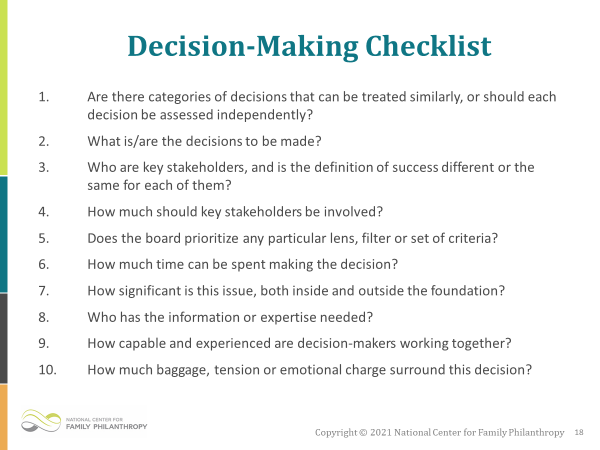Takeaways Blog on Demystifying Decision Making

Courtesy of fauxels from Pexels
This blog summarizes key notes from our May Fundamentals of Family Philanthropy webinar.
Philanthropic families employ a wide range of models to make decisions—from unilateral authority to consensus. However, identifying the appropriate structure is often a challenge and can serve as a barrier to effective philanthropic practices. Developing an appropriate decision-making framework for distinct situations allows families to rely on an established and agreed-upon process to find a solution smoothly and expediently. In NCFP’s recent webinar, Ann Shulman, Executive Director of Philanthropy Associates, discussed different decision-making models available to giving families, considerations for choosing the best framework for a family, and why refining decision-making processes is essential to an effective giving effort. Here are important takeaways from the discussion.
Decision making is not a one-size-fits-all situation—there are different approaches and models available that fit the circumstances of your family or a specific decision. Particularly in family philanthropy, relationships blend the personal and professional, and it can be complicated to make significant choices about the future of the collective effort without bringing in family legacy and history, values, and emotional baggage. Choosing and naming a decision-making framework helps individuals work more effectively together—everyone understands the rules of the road and what direction they’re heading. Decision-making models vary depending on what level of inclusion your family desires, as well as how much buy-in is needed to move forward on a decision. In general, there are three stages for building out your decision-making approach:
Step 1: Know Your Decision-Making Options
It is important to understand the different models for decision making at the board level and the advantages and disadvantages of each. Each family is different—holding different choices, relationships and emotions, and timelines for decisions—so it is essential to choose a framework that maximizes the decision-making potential of your family with its given circumstances. There are five main decision-making models:
Individual decides unilaterally
- With this method, an individual—usually the board chair—makes a unilateral decision and announces it to the board. This approach may also be used by a committee chair, a senior board member or any individual in a position to make the decision.
Unilateral decision, with input from individuals, or from the whole group
- In this case of individuals, one stakeholder is authorized to gather input from other individuals before making the decision and announcing it to the entire group. The key to using this method successfully is seeking input from appropriate stakeholders.
- In the case of input from the whole group, all stakeholders come together to share their perspectives on an issue but ultimately one person retains decision-making authority.
Delegation
- This method of decision making is useful in situations where a subset of the group is likely to have expertise about an issue, but where other stakeholders have one or more specific requirements for the decision being made. In a board environment, decisions may be delegated from the full board to a smaller committee to take on the discussion and decision-making process.
Board vote
- Most foundations use some form of voting to make decisions. Besides being a familiar method, it yields a definite outcome, includes everyone, and feels fair. The key to successful voting is informed, fair discussion before the vote is taken. The vote can be simple majority, a two-thirds vote, etc.
Consensus approach
- Reaching consensus does not mean that everybody has to be in perfect agreement with a decision; rather, it means that all stakeholders have an opportunity to express their views as equals, understand the decision as it is proposed, and can support the decision in words and actions.
- While it may not be everyone’s first choice, they can all live with the agreed-upon decision and accept that it meets the important interests of the group.
Depending on the level of inclusion and the level of buy-in your family prioritizes, you may be apt to choose a decision-making framework led by an individual or led by a collective body. The models with the lowest level of inclusion and buy-in are: individual decides unilaterally, or individual decides unilaterally with input from others. Delegation and a board vote are two methods with deeper inclusion and buy-in, with a consensus approach having the highest level of buy-in and inclusion overall.
Step 2: Decide How to Decide
After understanding and examining the decision-making models at your disposal, you must “decide how to decide”. Making this choice helps the framework become clear to all stakeholders involved. This decision is commonly made by the board chair, but it can be chosen by the head of a committee or another stakeholder tasked with making the choice.
There are a number of considerations to examine when deciding on a decision-making model:

Excerpt from “Demystifying Decision Making” presentation, developed by Ann Shulman
Step 3: Name it Up Front
After the decision-making framework is finalized, it must be communicated out to relevant stakeholders before another opportunity to make choices materializes. It is very important to be clear about how decisions will be made and how individual input will be used at the beginning of an undertaking, be it a family meeting, retreat, or series of meetings. Family members may feel ambushed or their opinions unwelcome if process isn’t communicated early and clearly.
A decision-making framework clarifies process—choices are made within a system that the family understands and respects. Furthermore, the family can make decisions dependent on a framework that fosters effective governance, and does not cater to specific personalities—conflict-prone or conflict-averse—past tradition, or outdated bylaws.
To learn more about decision making, the recording and transcript of “Demystifying Decision Making” are available exclusively for NCFP Friends of the Family and Partner Subscribers.
